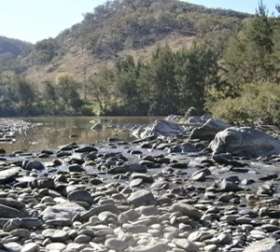Environmental risks of pipeline underestimated

A new UNSW-led study modelling the impacts of an approved $47 million pipeline pumping water from the Macquarie River to the city of Orange reveals far greater risks to river health than those estimated by the environmental assessment.
The pipeline, which will cost a further $728,000 per year to operate, was approved by the NSW Department of Planning and Infrastructure in May and the Planning Assessment Commission in June. However, UNSW scientists say there were critical flaws in the original environmental assessment.
"The original environmental assessment was based on dry climate conditions and the wrong pumping thresholds and there is increased opportunity to divert even more water in the future," says Professor Richard Kingsford, Director of the Australian Wetlands, Rivers and Landscapes Centre at UNSW.
Kingsford and his honours student Justin McCann independently modelled the impact of the pipeline on downstream flows to the river and Macquarie Marshes – which are listed by the Ramsar Convention on Wetlands of International Importance. They identified "critical issues of inadequate environmental assessment".
Key findings:
- The initial assessment said pumping could occur when flow levels were above 38 mega litres per day (ML/day). This is considerably lower than the 118 ML/day threshold identified by UNSW researchers.
- The UNSW model closely reflected an independent assessment commissioned by the NSW Department of Planning and Infrastructure, which recommended 108 ML/day.
- Current approval of the pipeline with a new pumping threshold of 108 ML/day has not had its environmental impact assessed.
- An upper threshold would not prevent increased water diversions. Enlarging the capacity of dams at Orange (e.g. Suma Park Dam or use of groundwater aquifer for storage) would considerably increase future diversions of water, inadequately accounted for in the environmental assessment.
- There is significant potential to increase the maximum amount of water diverted from 3804 ML per year to 4380 ML per year, by varying pumping thresholds.
"Our modelling identified the pumping thresholds were wrong, which was further supported by a government-commissioned assessment. What this means is that the approval is based on new thresholds which have never been properly assessed," says McCann. "The original environmental assessment has underestimated the ecological impact of this development."
Furthermore, Professor Kingsford says there's a loop hole in the water planning that will allow increased diversions of water from "one of the most seriously compromised rivers in the Murray Darling Basin".
"This assumes there is spare water where there is none. The Macquarie Marshes have suffered for more than forty years from diversions of water upstream for irrigation and towns. This is just another blow to its life-giving water supply," said Professor Kingsford.
The Australian Government is expected to make a decision on its environmental assessment under the Environmental Protection and Biodiversity Conservation Act 1999 in the coming weeks, with a particular focus on the impacts the development will have on the internationally recognised Macquarie Marshes.
More information: www.wetrivers.unsw.edu.au/2013 … ne_Report/index.html
Provided by University of New South Wales















